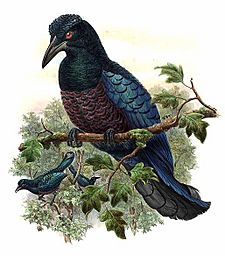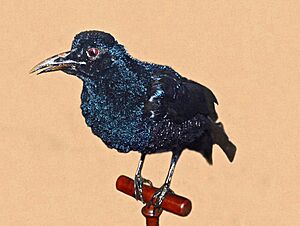Curl-crested manucode facts for kids
Quick facts for kids Curl-crested manucode |
|
|---|---|
 |
|
| Scientific classification | |
| Kingdom: | |
| Class: | |
| Order: | |
| Family: | |
| Genus: | |
| Binomial name | |
| Manucodia comrii Sclater, 1876
|
|
The curl-crested manucode (Manucodia comrii) is a fascinating type of bird-of-paradise. These birds are known for their unique appearance and special calls. They live in the forests of Papua New Guinea and nearby islands.
Contents
Who Named the Curl-Crested Manucode?
This bird was named by a British zoologist (a scientist who studies animals) named Philip Lutley Sclater. He named it after Dr. Peter Comrie. Dr. Comrie was the person who first discovered this bird on Fergusson Island in 1874.
Where Do Curl-Crested Manucodes Live?
Curl-crested manucodes mostly live in the upper parts of rainforests. They also like forest edges and woodlands. Sometimes, you can even find them in wooded savannahs, parks, and gardens. They prefer places with lots of trees and plants.
What Does the Curl-Crested Manucode Look Like?
The curl-crested manucode is a large, compact bird. It grows to be about 43 centimeters (17 inches) long. Its feathers are a beautiful mix of shiny purple, black, and green. It has bright red eyes, called an iris. The feathers on its upper chest and neck look crinkled and are a yellowish-green color.
One of its most special features is its curled head feathers. It also has twisted feathers in the middle of its tail. Both male and female birds look similar. However, the female is usually a little smaller than the male.
How Big Are They?
The curl-crested manucode is the biggest type of manucode. It is also the largest and heaviest bird in its family, the birds-of-paradise. These birds can weigh up to 450 grams (about 1 pound). Even though it's heavy, its tail is shorter than that of another bird called the black sicklebill.
How Do Curl-Crested Manucodes Behave?
Even though they might not be the brightest in color, curl-crested manucodes are amazing singers. They have a very special way of making sounds.
Their Unique Voice
In most birds, the windpipe (called the trachea) goes straight from the mouth to the lungs. But in the curl-crested manucode, it's different! Their trachea goes down towards their lower chest. Then, it coils back up through their belly area before reaching their lungs. This special windpipe works like a musical instrument. It helps the bird make a soft, flute-like sound. You can hear this sound from far away!
Courtship and Territory
These special calls are often used during courtship. This is when male birds try to attract females. The males will follow the females through the plants, spreading their wings and tail. They also raise their bodies in a proud, strutting way. Manucode pairs also use their voices to protect their home areas. They sing to warn other birds to stay away from their territory.
What Do They Eat?
The diet of the curl-crested manucode mainly consists of ripe fruits. They especially love to eat figs. They also eat insects and other small creatures without backbones, like worms. These birds usually live in pairs or in small groups. Each group has its own territory where they find food and raise their young.
See also
 In Spanish: Ave del paraíso de Comrie para niños
In Spanish: Ave del paraíso de Comrie para niños


